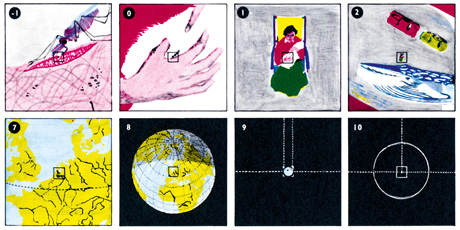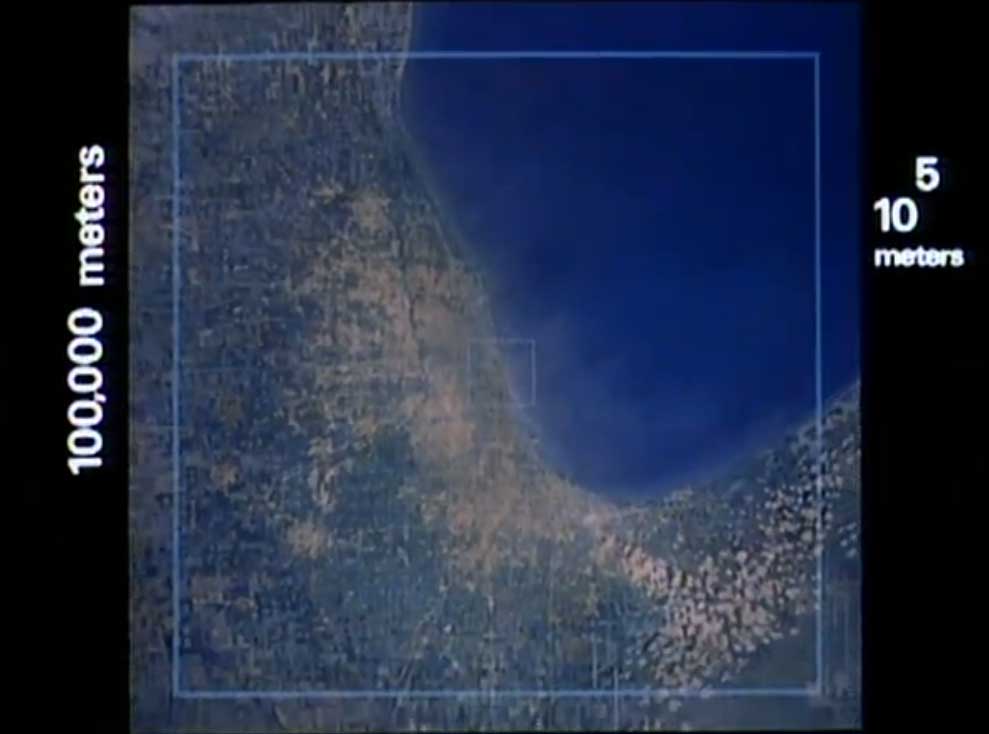Introduction and argument
Powers of Ten is a highly influential short ’documentary-style’ movie directed in 1977 by life partners Charles and Ray Eames (dir. 1977). Through its 9 minutes we are assisted by a narrator in our journey to explore the vast scales of the universe, as we lift up vertically from a man lying asleep in a picnic scene in Chicago into outer space, and as we reach the perimeters of material existence, a replay starts and we then suddenly plunge back into the deeper levels of the man’s body, accross tissue, cells, DNA and finally terminating at the level of subatomic particles. The film gets its name from the fact that we are moving through the mathematical orders of magnitude of the powers of ten on a logarithmic scale (which makes our movement seemingly linear in time), with every ten seconds reaching ten times greater (or smaller) altitudes and frames of vision than in our previous positions. This film is an interpretation of a small educational book, Cosmic View by Dutch author Kees Boeke (1957), which used pictoral ’snapshots’ of different levels in the journey.
Boeke’s graphics of levels of magnitude (Boeke 1957)
Powers of Ten is actually two movies, since the Eameses created its first ’sketch’ version in 1968 with a more telling title of A Rough Sketch for a Proposed Film Dealing with the Powers of Ten and the Relative Size of Things in the Universe (hereafter: Rough Sketch; dir. 1968)[1]. Scientific representations such as these have significant impact on forming popular culture and opinion through their circuits of culture (Burgess and Gold 1985; Du Gay 1997; Cloke et al. 2004: 104). This film quickly became very popular and was widely distributed as educational material, even quite recently it has been circulating on the internet in a new, „updated”, web-based remake version as an interactive application (Huang 2012), but there is also a blog on the film (Powers of Ten Blog 2012), and an interesting interpretation trying to transpose its idea onto Earth’s history (Long Now 2012), and it has even been distributed widely by geographers (e.g. on the list server for critical geography). As for my personal application, during a workshop on critical urban studies in Hungary, which became „invaded” by critical geographers such as myself, I held a class on the topic of scale, where I used the film as a demonstration by deconstructing its underlying narratives, drawing heavily on Mark Dorrian’s recent article in a magazine (Dorrian 2012).
My argument will be that the film should not be evaluated as just a useful and impressive demonstration of proportions and scale in the world, but can in fact only be understood in the light of its original Cold War techno-political context and as a vehicle for a certain type of geographical knowledge and imagination (Gregory 1994; 1995). The film is a manifestation of the close connections between different technologies and knowledge, as Cold War ’technoscience’ rested on great investments and developments in instruments of perception and quantification, machines of calculation (computation), modelling, manipulation and space science, and also a certain positivistic ideology of science. In analysing the film, I will be ’reading it out’ as a text (Chatman 1978: 41-42), decoding signifiers from its semiotic landscape and deconstructing its master-narrative in order to unfold the specific cultural, political and ideological messages it is trying to address to the viewer (see Jackson 1989: 47–54). In this analysis, I am drawing heavily on semiotics and theories of narrativity, especially on film and media (Chatman 1978; 1990; Currie 1998; Lothe 2000; Mitry 2000), another important resource is the philosophy of poststructuralism (Said 2003; Derrida 1993; 1998) and resources explaining contextual background relations in which the film should be placed.
A glimpse of the Cold War context
Powers of Ten was one of the directors’ final films. The Eameses had good relations with contemporary US mega-corporations, and were also ingenious designers of consumer goods of modern technology of their time. As Dorrian (2012) describes, their whole activity followed the shift from a modernist economy of consumer goods to a postmodernist economy of sign production. Apart from Powers of Ten, they also created for IBM an educational-cum-ideological film on computer technology, The Information Machine (dir. 1958). They even made an installation called Glimpses of the USA (dir. 1959), which was one of the main attractions representing American society at the American National Exhibition in Moscow (coordinated by the United States Information Agency), and where the famous ’kitchen debate’ between the capitalist USA and the communist USSR took place. Therefore, the directors’ activity and the meanings entailed in their products can only be understood in the geopolitically contested epistemological (Edwards 1996) and regulating (Du Gay 1997) context of the Cold War era.
The symbolic setting of the picnic scene
Although the opening few seconds of a couple having a picnic seems rather secondary for the whole framework of the film and relatively unimportant after the unfolding immensity of surrounding global (subhuman) space (other versions used different opening settings; Boeke 1957; Eames and Eames dir. 1968; Szasz dir. 1968), it is key in understanding the film’s whole message, because it develops the setting for our long travel in carefully planted symbolics.
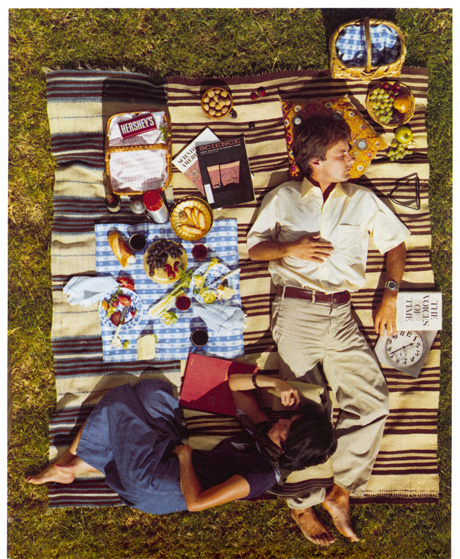
The picnic scene
As Dorrian (2012) highlights it, on the blanket there lies a book, Voices of Time (1966), edited by J. T. Fraser, a contemporary physicist and social scientist, which is about the philosophy of time, and which also has a mandala on its cover. However, as Dorrian notes, this title is also identical to a science-fiction novel by J. G. Ballard, The Voices of Time and Other Stories, where the main character is a scientist interestingly called Powers, who is suffering from a fatal ’narcoma syndrome’, seeing numbers of a catastrophic countdown, and following the dystopic visionary of the story, he eventually falls asleep (just as the man in the picnic) for eternity in the middle of a mandala, where his mind dissolves into the universe. There are other less complex signifiers showing the importance of time: below the book is another one with a cover of a large clock, and the man’s wristwatch is also pointing directly towards us. There are also two magazines, Scientific American and Science, both prominent works of ’high’ science, which not only suggest the ’sleep into reason’, as Dorrian shows, but also point to the national scientific regime we are being subjected to, since these are symbols of the actual producers of the knowledge and technology which will enable us our space travel and to perceive underlying entities of the physical world. Becoming subject to these powers, we become the subjects of technology, which is in the forefront of Cold War imperialism, as science became a ’national project’. But in my view, not just the symbolic setting, the camera angle is also important: for just a few seconds, but we see the couple from a horizontal, lively perspective, quite close to us, their faces happy. As the narrator describes, „the picnic near the lakeside of Chicago was a start of a lazy afternoon, early one October” (Eames and Eames dir. 1977). Getting into such rich subjective detail serves to relax the viewers mind, and opens the plot, showing the raw material of which the rationally measured compartmentalizing would work with. Dorrian (2012) tellingly notes, that the outward zoom is a „vertiginous, abyssal collapse of the everyday reality”, but here this reality is also the asymmetric ’Other’ of the narrative (Said 2003), the aporia of the text, where the dichotomy could be contrasted with and broken up against the logocentric master-narrative of the film (Derrida 1993; 1998). We might say that sensual place itself, as the ’world of humans’ is represented in the picnic scene, which will be devoured by the infinite, progressive space of eternal material existence and mathematical rationality (see e.g. Agnew 2005).
The master-narrative of the plot: travel in space and time
When we lift off, the fixed framing and the stable movement of the camera suggests that we are not in control, rather we are following the lead of technology, it is like we are riding a rocket. In fact Rough Sketch is much more revealing, since the camera starts from Florida, the ’emblematic point of departure for the Apollo missions’ (Dorrian 2012). The role of the narrator is crucial, since it supplements the narrative effects of the medium of visuality with an oral guidance on identifying the entities which are unfolding (Lothe 2000: 41), therefore the viewer is given a structured sequence (Chatman 1978: 30). This narration helps to form a story guideline, but also strengthens the film’s documentary style (it is in present tense), contrary to it being actually a fiction. This is necessary because the entities presented, although exist in reality, are fictious in the sense that they are graphic representations, and are carved out of reality by the language of science, thus appearing as holistic forms, Gestalts on the screen. Behind his seemingly passive observer image, the narrator therefore has complete control and power over events and ’sees through’ the linear scales, he is in the ’God’s eye’ view of the camera – he is more our pilot in the rocket ride, the spokesperson of technology, native to the unfolding new world.
In the film, scale is represented as a continuous, relative immanent substance, which cuts right through and reorders the physical reality of the world in mathematical proportions. The previously ’destructed’ reality thus becomes measurable, and this measurement in advance gives it meaning for abstract consciousness by making it rationally observable and explainable. The importance of vision is crucial here, for we are presented with a mirror-reflection of reality (we are presented with facts, concealing the apparatus and locally produced knowledge used to create these particular representations of reality), and the linearity develops an intimate linkage between thought and vision (Burnett 1995: 3–14). The film builds on a masculinist disembodiment, a modernist detachment of senses (touch, smell, hearing), we measure solely with our eyes, to „a position in which the body devolves into the eye, and vision shifts from exploration to consumption, from the insecurities of watching to a fixed gaze.” (Burnett 1995: 5) This ’cartographic rationality’ of holistic depiction is enforced by the ideology of vision (Cosgrove 2003; 2006), and since the film is only ’one cut’, we are locked in a bounded, striated space that only seemingly opens. The linearity and ’God’s eye’ ’view from nowhere and from everywhere’ of the camera serves to naturalize this idea of scaling order by the ’God-trick’ (Haraway 1988) of enmeshing human relations into an abstract totality, and subjecting human life to this overarching Cartesian anxiety of a geometrized order (Bernstein 1983), which is a product of a particular kind of embodied vision and technological regime (as in other cases of abstract space and the geometries linear perspective: Cosgrove 2003; 2006; Olwig 2002). I should remark here, concerning geographical knowledge production, that in geography, „quantifiers” were drawing on this same relativity rising from systems theory to question the „absolute” space of previous regional geography, the one this film is also to defute, presenting a „relative” space (see e.g. Barnes 1996). Regions, fixed and particular areas of human culture (Chicago, America, Earth) are broken up by a scientistic master-narrative of mathematical manipulation and computation.
Chicago
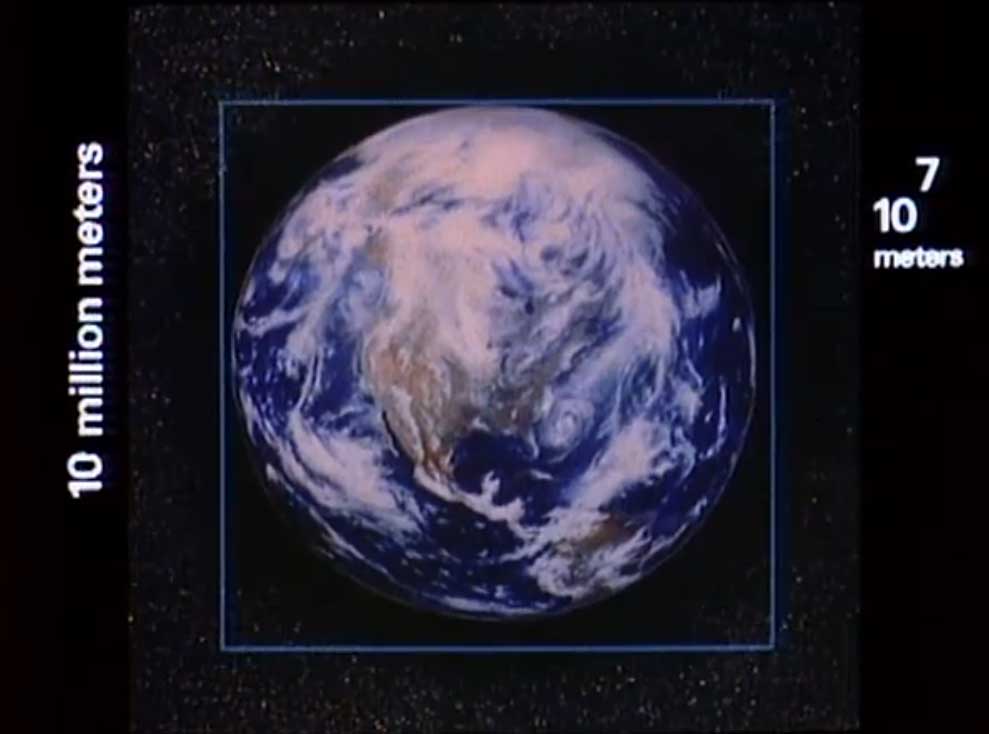
Leaving Planet Earth
But if scale brings relativity and is continuous, are there scalar levels, which have autonomous ontological fields of existence? Through this travel, we meet in every enmeshed ’step at a ten’ with a new world of beings, the narrator marking them out from the linear rush: atoms, cells, galaxies etc. (Eames and Eames dir. 1977). These are the entities of the natural sciences, and foremost physics – this shows the uneven importance of different sciences in the period, and especially the high dominance of physics. This Cold War picture of ’big science’ still sits strong in today’s perceived image, and since physics deals with the ’grand scales’ of our universe (from atom to universe), the whole travel is a hymn for this ideology. As Dorrian (2012) rightly concludes, there is a circular narrative along the curve connecting the two points of the (starting) outer space of space and the (ending) inner space of the subatomic level, which practically devour and dominate the tiny level of human existence (see Appendices 5. and 6.). This rythm also creates a sense of wholeness (Mitry 2000: 221–223), which universalizes and naturalizes the specific idea of scale.
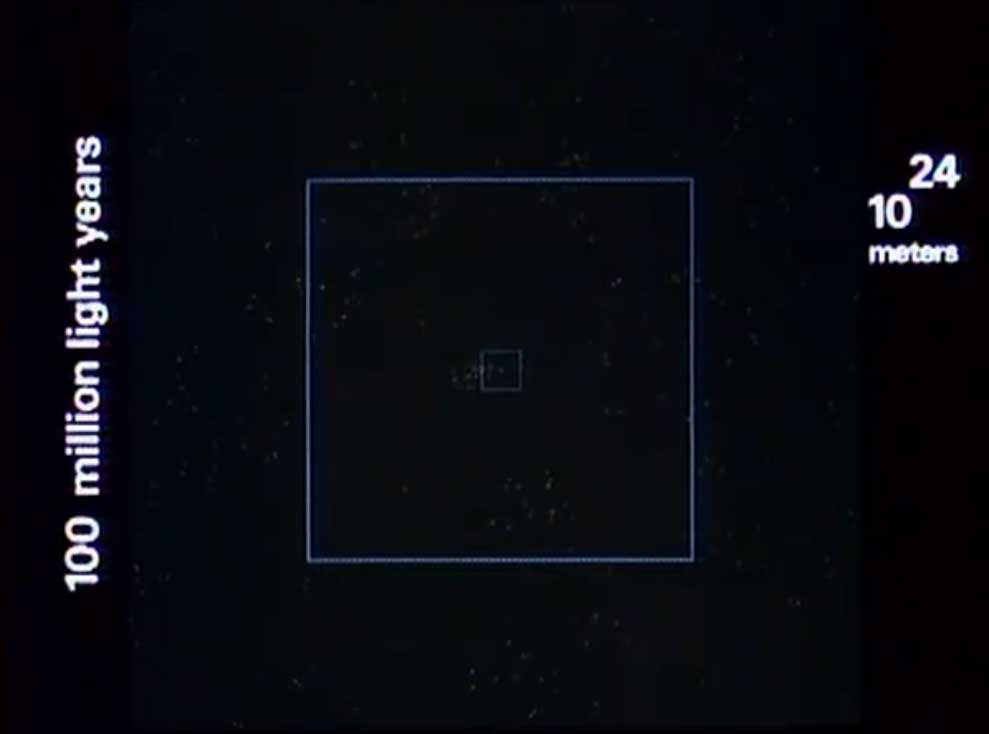
The void
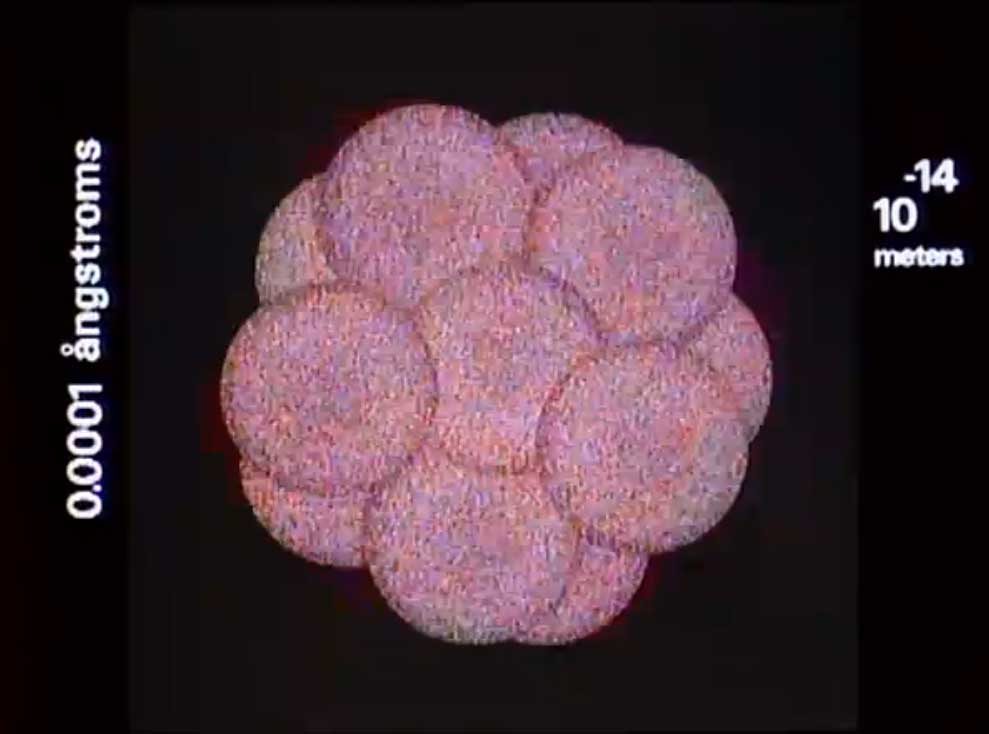
The subatom level
There is also a sort of colonial narrative running underneath, since the ’opening up’ function of mathematics and the ’looking down’ vertical angles enforce an urge for adventure and conquest into the newly unfolding ’void’ but ’energetic’ worlds (Gregory 1994), therefore supporting a masculine narrative of control and manipulation (Haraway 1988), which fits well with the ideology of the Cold War nation-state subjecting people under the infinite progress of science and technology (Edwards 1996). This idea of progress connects back and associates to the temporal symbolics of the picnic scene, since the travel in space is a travel in time as in the seemingly proportional spatial travel we are actually accelerating outwards (in fact, in Rough Sketch, there are counters on the left of the screen measuring Earth and space time), and when diving into subhuman levels, the ’world of atoms’ show a speeded-up environment of a futuristic utopia. And this in all closes the circle.
Conclusions
In my view, Powers of Ten represents a Cold War ideology of science, where the subject of the individual becomes interpellated through the ideology of technology and mathematical rationality to the nation-state (Currie 1998: 17–32). Narrativity is substantial in constituting the subject through repetition, as
„it repeats and confirms the possibilities of identification that have already constituted our subjectivities. This is more than claiming that narrative reflects life. It is saying that narrative is one of the ways in which identity, the ideological subject, is manufactured.” (Currie 1998: 32)
The travel through space is a travel through space-time with an embedded hierarchy of space dominating over place and time dominating over space, showing a futuristic-utopistic mentality, which aims the subject towards the missionary conquest of space travel. The void of outer and inner space resemble to a modernist open space of free manipulation and colonial conquest, as man brings order to everyday-life reality through mediating abstract space. The conception of scale is epistemologically constructed through human relations (see Herod 2011), and the geometrized vision of scale presented here is a specific construction universalized through a careful association of signifiers.
REFERENCES
Agnew, J. (2005) Space : Place. In: Cloke, Paul – Johnston, Ron J. (eds.) Spaces of Geographical Thought: Deconstructing Geography’s Binaries. Sage, London – Thousand Oaks – New Delhi, 81–96.
Barnes, T. J. (1996) Logics of dislocation: Models, metaphors, and meanings of economic space. The Guilford Press, New York and London.
Bernstein, R. (1983) Beyond objectivism and relativism: science, hermeneutics, and praxis. University of Pennsylvania Press, Philadelphia.
Boeke, K. (1957) Cosmic view: The universe in forty jumps. The John Day Company, New York.
Burgess, J. and Gold, J. R. (1985) Geography, the media & popular culture. Croom Helm.
Burnett, R. (1995) Cultures of vision: Images, media, and the imaginary. Indiana University Press, Bloomington and Indianapolis.
Chatman, S. (1978) Story and discourse: Narrative structure in fiction and film. Cornell University Press, Ithaca and London.
Chatman, S. (1990) Coming to terms: The rhetoric of narrative in fiction and film. Cornell University Press, Ithaca and London.
Cloke et al. (2004) Practising human geography. SAGE.
Cosgrove, D. (1993) The Palladian landscape: geographical change and its cultural representations in sixteenth-century Italy. Leicester, Leicester University Press.
Cosgrove, D. (2003) Apollo’s eye: a cartographic genealogy of the earth in western imagination. The Johns Hopkins University Press.
Cosgrove, D. (2006) Geographical imagination and the authority of images: Hettner-Lecture 2005. Steiner, Stuttgart.
Currie, M. (1998) Postmodern narrative theory. Macmillan Press, London.
Derrida, J. (1993) Aporias. Stanford University Press, Stanford.
Derrida, J. (1998) Of Grammatology. The Johns Hopkins University Press, Baltimore and London.
Dorrian, M. (2012) Adventure on the Vertical: Powers of Ten and the Mastery of Space by Vision. Cabinet, 2012, 44, 17–23.
Du Gay, P. (1997) Doing cultural studies: the story of the Sony. Sage.
Eames, C. and Eames, R. (dir. 1958) The Information Machine: International Business Machines (IBM), Office of Charles and Ray Eames.
Eames, C. and Eames, R. (dir. 1968) A Rough Sketch for a Proposed Film Dealing with the Powers of Ten and the Relative Size of Things in the Universe: Commission on College Physics, Office of Charles and Ray Eames.
Eames, C. and Eames, R. (dir. 1977) Powers of Ten: International Business Machines (IBM), Office of Charles and Ray Eames.
Edwards, P. N. (1996) The closed world: Computers and the politics of discourse in Cold War America. The MIT Press, Cambridge and London.
Gregory, D. (1995) Imaginative Geographies. Progress in Human Geography, 19(4), 447–85.
Gregory, D. (1994) Geographical imaginations. Blackwell, Cambridge and Oxford.
Haraway, D. (1988) Situated Knowledges: The Science Question in Feminism and the Privilige of Partial Perspective. Feminist Studies, 14(3), 575–599.
Herod, A. (2011) Scale: Key Ideas in Geography. Routledge, London and New York.
Huang, C. (2012) The Scale of the Universe 2. Available at: http://scaleofuniverse.com/ [Access date: 2 Dec 2012]
Jackson, P. (1989) Maps of meaning: An introduction to cultural geography. Routledge, London and New York.
Long Now (2012) The Long Now Foundation web-site. Available at: http://blog.longnow.org/02007/09/09/history-by-the-powers-of-ten/ [Access date: 2 Dec 2012]
Lothe, J. (2000) Narrative in fiction and film: An introduction. Oxford University Press, Oxford.
Mitry, J. (2000) Semiotics and the Analysis of Film. The Athlone Press, London.
Olwig, K. R. (2002) Landscape, nature, and the body politic: From Britain’s renaissance to America’s New World. The University of Wisconsin Press, Wisconsin.
Powers of Ten Blog (2012) Powers of Ten Blog web-site. Available at: http://blog.powersof10.com/ [Access date: 2 Dec 2012]
Said, E. (2003) Orientalism. Pengiun Books.
Silleck, B. (dir. 1996) Cosmic Voyage: IMAX.
Szasz, E. (dir. 1968) Cosmic View: National Film Board of Canada.
NOTES
[1] Curiously there is also a Canadian version of the same idea, Cosmic View, which is more explicitly based on Boeke’s book, uses more sketchy drawings than realistic, documentary-like images, has a more pleasant music instead of futuristic sci-fi themes, and goes without a narrator (Szasz dir. 1968). Even more curiously, there is a very modern reinterpretation of this idea produced by IMAX, Cosmic Voyage (Silleck dir. 1996), where the narrator is the Hollywood star Morgan Freeman. I have used Powers of Ten as the demonstration of this ’idea’ for several reasons, but above all because of the delicate symbolics that are developed in the movie, as against other interpretations.
